Photos with this report (click to enlarge) | |||
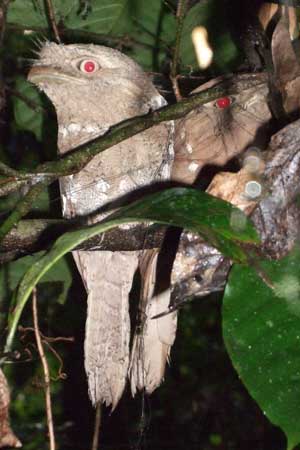 Ceylon Frogmouth |
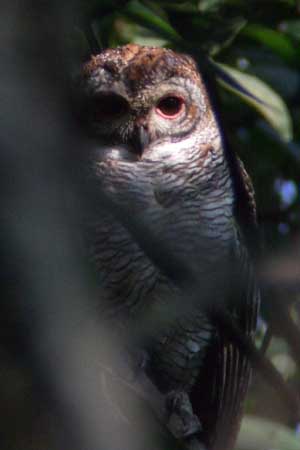 Mottled Wood-Owl |
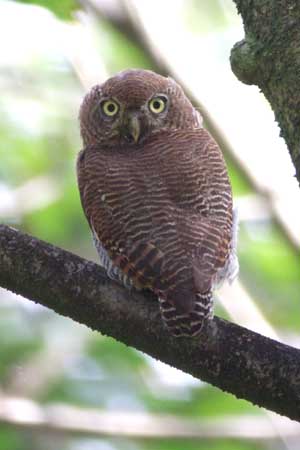 Jungle Owlet |
|
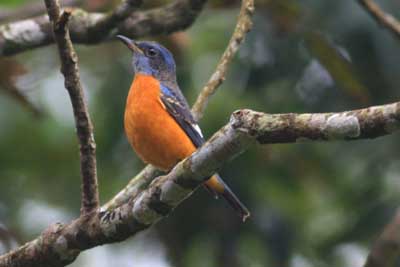 Blue-capped Rock-Thrush |
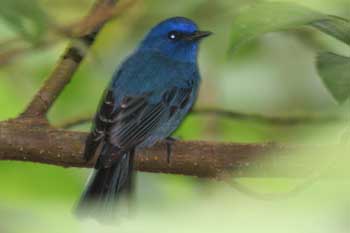 Nilgiri Flycatcher |
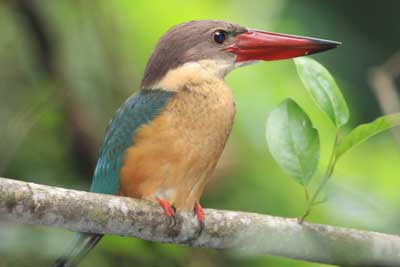 Stork-billed Kingfisher |
|
This short report updates information available on the web concerning several key birding sites in central Kerala that I visited as part of a week-long independent trip in November 2010. Having limited time, and spending some of this relaxing on a houseboat (at Kumarakom) in the backwaters and touring Fort Cochin, birding was limited to the key sites of Thattekad, Munnar and Periyar, Even so, and despite the north-east monsoon drenching us on two afternoons, the birding was great and the trip both enjoyable and a real success in terms of species found. Kerala is a fabulous part of India, combining excellent scenery and easy birding with a relaxed ambience and sensational food.
Ground arrangements
These were made, after a bit of shopping around, with http://www.spholidays.com/ (email Sunil at spholidays @ airtelmail.in). I gave them an approximate idea of what we wanted, and asked them to book accommodation for each night and provide us with a driver. This they did, and all arrangements were perfect. They certainly come recommended for sorting out tours of southern India. I don’t think they specialise in birding and I am not sure if they have any dedicated bird guides (I didn’t want one, so didn’t ask) but they clearly knew what they were doing. Brief details of accommodation, and distances to each location, are provided below.
Weather
Rather wetter than we anticipated! The south-west monsoon ends in September / early October, but Kerala, despite its westerly aspect, seems to take a decent hit from the north-east monsoon (October – December) as well! We had up to several hours of rain on four afternoons / early evenings out of seven, although it only seriously stopped play on the first day at Thattekad. Interestingly, Munnar, which might have been expected to be wettest (being highest; c.1200m asl) was mostly cloudy and misty from about 1100 onwards, but we had no real rain in 2 full days here. Thatteked (c.500m asl) and the lowland backwaters at Kumarakom and nearby Cochin were distinctly warm and rather humid when the sun was out, whilst Periyar (c.800m asl) was cloudy and fairly cool in the 24 hours we spent there. Leeches abounded at the latter location and, as might be expected, were out in droves after a night of heavy rain; those White-bellied Blue Flycatchers cost a bit of blood! Thattekad also had a few leeches but a lot of the birding here is done from wide trails on the forest edge; Munnar had none. We also enjoyed a sprinkling of mosquitoes everywhere apart from Munnar but they were only really significant in the backwaters.
Guides
At Thattekad we stayed at Hornbill Camp, where we pretty quickly met Abhilash (Abhilashthattekkad @ rediffmail.com or naturalist @ lemongrassecolodges.com; mobile 09946139050). He is employed at the camp, and spends a lot of his time taking guests into the forest. After spending a day birding myself, I went out with him the following day for five hours in the morning, and three more in the afternoon. He was a great bird guide and a really nice person to spend some time with. I also spent an hour with him the following morning hunting for Mottled Wood Owls, and he gave me a load of good current gen for Munnar, our next destination. Access to the famous sanctuary area was not simple (at least during our visit; see below) and there are several locations that need good local knowledge to reach, so using somebody like Abhilash may be the only way to properly see Thattekad on a short visit.
In Periyar, we walked into the park the afternoon we arrived and, soon after reaching the jetty, bumped into Raj Kumar (mobile 08086839128; address: Periyar Tiger Reserve, Thekkady, Kerala, South India Pin Code 685536). He is employed as a guide at the reserve (and can also be reached by asking at the booking office just across the road from Hotel Ambadi in Thekkady village) and agreed to come birding the following morning. Like Abhilash, Raj was excellent company and a very good birder and natural historian; he knows Periyar inside out. An early morning walk with a guide is the only way to get away from the main road and tourist chaos of Periyar, so going with somebody like Raj is essential just to get any true feeling for the place, let along see any proper forest birds.
Books and references
I used my trusty Birds of the Indian Subcontinent by Grimmett, Inskipp and Inskipp and found it perfectly adequate. Some of the taxonomy has been superseded (possibly prematurely) by Rasmussen and Anderton’s Birds of South Asia but many of the latter’s new ‘species’ are illustrated as subspecies in the former. I also dug out a few trip reports from the usual sources but the only really good one was http://www.birdtours.co.uk/tripreports/india/india25-sw/sw-india-03.htm by Kolbjørn and Kjetil Schjølberg. This is a bit out of date now but still very useful, and includes maps for a couple of key species. Thanks also to Graham Talbot, who emailed me his useful report (available on request from my address above).
Sites visited
1 Thattekad area (less than 2 hours from the airport at Cochin)
The main attraction here is the small but rich tropical rainforest reserve, set amidst rolling hills on the banks of the Periyar River. We arrived at Hornbill Camp to find that there had been no access to the sanctuary area for two months and counting, for reasons that I couldn’t quite fathom, despite having it explained to me several times. Infantile Indian bureaucracy seemed to have a lot to do with it. This was frustrating as Hornbill Camp, on the opposite bank of the river, looks onto the sanctuary. The closest we got was a kayak trip one afternoon. Abhilash reckoned not being able to get into the sanctuary made Grey Junglefowl, Indian Pitta, White-bellied Blue Flycatcher and Grey-headed Bulbul much harder, but most of the other specials could be found elsewhere. We had to wait until Periyar for the former, but got the pitta and flycatcher outside the park. I did not see the bulbul anywhere, but give me a pitta any day!
A Hornbill Camp This is a great location to stay, with good birding from your veranda and during breakfast. We spent the first day just ambling round here, along the nearby track and around the small temple trying to recover from an overnight flight into Cochin. Appropriately, Malabar Grey Hornbill appeared in the garden on the first morning, soon after White-cheeked Barbet (common).
• Other notable species included: Oriental Honey-Buzzard, Black Eagle, Black Baza (all by scanning the hills of the sanctuary), Green Imperial Pigeon, Emerald Dove, Vernal Hanging-Parrot (common), Plum-headed Parakeet, Great Eared Nightjar (scan open areas at dusk), Jungle Owlet seen very well (rufous-toned malabaricum race), Indian Swiftlet, Chestnut-headed Bee-eater, Asian Fairy Bluebird and (Lesser) Hill Myna.
On my last morning, I met up with Abhilash who took me to his site for Mottled Wood Owl at a marshy roadside clearing near Thattekkad village. He had not seen it for a long time, due, he thought, to increasing disturbance but we duly flushed one that then paused for a good glare at us. This on its own was excellent but while closing in on the owl we then heard two India Pittas calling and, 15 minutes later, had teased one out for a superb view. Ting-a-ling! We also found Pin-tailed Snipe and Yellow-billed Babbler here.
Although Hornbill Camp looks onto the sanctuary, the surrounding areas are mainly overgrown rubber plantations and rice paddies. This means that not easy to get into any decent forest (the access point to the sanctuary, when open, is c. 6km away by road), so trips further afield are necessary to search for some of the more interesting species.
B Urulanthany (45 minute drive from Hornbill Camp) This remnant forest patch, near the village of the same name, is a well-known birding site and I spent a slow, thorough morning here with Abhilash. We didn’t cover a lot of ground, but walked a wide trail and climbed up onto a low hill to view the surrounding forest edge. There was plenty going on, with highlights including White-bellied Blue Flycatcher (unusual here, by all accounts), Indian Blue Robin (also scarce, but Abhilash had found this individual a week earlier) and, head and shoulders above the rest, a magnificent close pair of roosting Ceylon Frogmouths.
• Other notable species included: Crested Goshawk, Oriental Honey-Buzzard, Malabar Parakeet (common in flight, but it took us a long time to find one perched), a splendid pair of Malabar Trogons, Black-crested Bulbul (of the ruby-throated subspecies gularis), Blue-throated and Brown-breasted Flycatchers, Brown-cheeked Fulvetta, Thick-billed (‘Nilgiri’) Flowerpecker, the endemic and stunning Crimson-backed (Small) Sunbird and the attractive southern Ghats form of Chestnut-tailed Starling, blythii.
C Edamalayar Dam (one hour drive from Hornbill Camp) This is another well-known birding site and apparently very productive in the mornings, when there is a chance of Wynaad Laughingthrush well uphill of the dam. We visited in the afternoon and found it much quieter, but still well worth a visit. We drove all the way to the dam, finding the snazzy White-collared Treepie on the road in and then hiked back downhill. Malabar Whistling-Thrush (common on voice) and Heart-spotted Woodpecker were the best finds, but we also had both Crested Goshawk and Shikra giving sensational views, White-rumped Spinetail, Brown-backed Needletails, Dusky Crag Martin and Crimson-backed Sunbird.
2 Munnar area (2 ½ hours from Hornbill Camp)
This small, but cheerfully scruffy town is in the heart of central Kerala’s tea plantations. As such, most natural forest has gone but small, lush patches (sholas) remain on the steeper slopes and some good ones are close to town.
We stayed at Copper Castle Hotel, reached by turning right off the NH49 and across the bridge at the top of the valley a few km before Munnar. Copper Castle is the first hotel you come to here, but there are quite a few others in the next few km. The advantage of staying at any of these is that you can easily walk to Deshadan, the key birding location in the Munnar area.
A Copper Castle overlooks a patch of indigenous vegetation clinging to a steep gorge and we found the garden and adjacent forest edge pretty birdy. We quickly made acquaintance with Nilgiri Flycatcher (abundant) and Grey-breasted LaughingThrush (nearly as easy).
• Other species here included: Blue-capped Rock-Thrush and Yellow-browed Bulbul, plus many common species of upland forests.
B Deshadan Resort (30 minutes + birding time by walking from Copper Castle) Deshadan is on a very steep, single-track road on the left about 2 km beyond Copper Castle (look for the signpost). It is excellent forest all the way up this road, and Malabar Whistling-Thrush is hard to miss on the road at dawn. I spent one afternoon and two mornings pre-breakfast birding here and, eventually, scored the Ace of Spades, and a few Kings, plus Painted Bush-Quail for the Joker too.
This site is mapped in the trip report alluded to above [http://www.birdtours.co.uk/tripreports/india/india25-sw/sw-india-03.htm] as Figure 2 but, as this was written about 7 years ago, some of the details have changed. For that reason, I provide a detailed breakdown of the situation as of November 2010 below.
• There is now a tar road all the way to Deshadan Resort. Nilgiri Woodpigeon was present both mornings at dawn in the tall trees in front of the resort, although it was also easy to find by clambering around in the treeline woodland further up (see below). I expected to have a fight on my hands for this one, but not a bit of it.
• Walk through the resort on the tar road, past the highly original penguin dustbins (!) and hit the old track that continues uphill from the end of the tar. Halfway between the resort and first hairpin (2-300 metres in all) there is a large clump of bamboo on the right; I was fairly sure I had White-bellied Short-wing (White-bellied Robin) singing here one morning but couldn’t extract it. On my last descent, at this first hairpin I finally nailed the wonderful Black-and-Orange Flycatcher (having previously spent a long time looking further up the slope). One of a pair actually perched on the old metal sheet and drum on the hairpin, and his mate could be heard calling further into the forest. Listen for their somewhat peculiar call (for a flycatcher); a rather soggy, low ‘chchchchchch’ and look for them low in the understory. This species seems not to be common in the Munnar area; they appear to be far easier at Cairnhill Forest, Ooty (way to the north), but we weren’t going there.
• At the third hairpin (less than 10 minutes walk from Deshadan, unless you have fallen in with the flycatchers) the track goes straight ahead into the uppermost part of the shola. This is reputed to be a good spot for Black-and-Orange Flycatcher and I looked hard here, but with no success. Nilgiri Woodpigeon was a shoo-in, however (seen several times here).
• At this third hairpin, the ‘main’ track turns right and becomes very pebbly and rough. Follow this for less than 100 meters, and then there is a narrow, steep incline on the left. Take this, go through the narrow plantation (yet more woodpigeons here too!) on the marginal path and clamber over the small stream on at the far end to reach the grassland of the open slopes. Now the fun begins! These slopes are the home of the drab-looking, skulky and monumentally boring Broad-tailed Grassbird. However, it is almost as rare as it is boring, so I devoted one hour each morning to it. The problem is that these slopes are steep, covered in waist-high grasses (many with razor-edged leaves), soaking wet (at least in the early morning) and very irregular underfoot, with tussocks, small holes, large boulders and the odd stream to negotiate. There are a few tracks on the slope but they seem to be mainly used by elephants, which presumably are yet another hazard if present. On the first morning I brought the scope, clambered onto the nearest big flat rock and scanned for an hour, to no avail. Next day I abandoned the scope, camera and any hope of ever being able to use that particular pair of shoes again and battled up onto the ridge, a struggle of about 15 minutes. Here things were much better, as there is a muddy ridge track that can be easily followed for a km or so at least in either direction. Soon after getting up here I found a grassbird, perched out on a tall grasshead on the slope below; it soon fled but coming within 60 seconds of Painted Bush-Quail I wasn’t complaining. I later had much better views of another grassbird on the other side (looking down onto Munnar) and climbed the ridge to marvel at Hill Swallows and Dusky Crag Martins, not to mention what felt like most of Kerala underneath me.
• Other species in the Deshadan area included: Bonelli’s Eagle, Alpine Swift, Greater Flameback, White-cheeked Barbet, Red-rumped Swallow, Asian Paradise and Nilgiri Flycatchers, Grey-breasted LaughingThrush, Indian Scimitar-Babbler, Blyth’s Reed Warbler and Crimson-backed Sunbird. All the Phyllos seemed to be Green(ish); not a whiff of either Large-billed or Tytler’s.
C Eravikulum National Park This is the other main birding location in the Munnar area. It is reached by taking the road out of Munnar for about 35 minutes. You have to park at the edge of the park, pay for a ticket, and then get a transfer bus the last 4 km up to the café. This all seems fine in theory (if somewhat pointless; why on earth can’t you hike the last 4 km: there is a tar road and it is mostly through tea plantations?) except for the fact that, as is typical in India, infrastructure cannot cope with the number of people using it. We arrived at 11am mid-week to find a queue of tourists that would have taken at least 2 ½ hours to get through! There were three small buses running and, unlike just about every other bus in India, the number of passengers strictly matched the number of seats. The result was an interminable wait as chaos reigned all around; whoever had decided, in a fit of utter insanity, that Delhi was ready to host the Commonwealth Games clearly had not visited Eravikulum. Anyway, we couldn’t face it, so cleared off and returned after 1400, to find that we had a mere 70 minute wait for the privilege of a bus up. We elected to stick it out, and, in the end, that proved a very good decision indeed.
Up at the top, you have reached high altitude grassland with big, sweeping slopes reaching up to sheer rock-faces that swirl in and out of the mist. You can walk about 1.5 km further uphill before reaching the ‘This is the Limit’ sign (which, if you are still surrounded by hundreds of noisy tourists, many of whom moronically think it is ok to point their camera at you, you will be able to relate too). However, don’t despair, the first bird we found on reaching here was Nilgiri Pipit, a pair of which gave very nice scope views on the track further up, and on the grass and boulders on either side! Despite the cloud, crowd and lateness of the day, we then found White-bellied Short-wing singing from a small ravine right on the road, and then another right out in the open (albeit under deep shade) in the ‘effluent seep’ running off the café just beyond the bus-stop. One other trip report I read also saw mentioned finding a short-wing here, so this really does seem to be a good place for them. I also saw (Indian) Blackbird very nicely here, plus Grey Wagtail, Common Buzzard and lots of Pied Bushchat nearby. We had our first Nilgiri Languar by the café and upwards of 30 Nilgiri Tahr on the slopes, so everything seemed well worthwhile in the end!
D Mattyputty Dam (one hour from Munnar) We made a short visit here, in the faint hope that the melee at the base of Eravikulum would subside. It is nice countryside, but natural forest is very scarce. The only significant find was a Nilgiri Woodpigeon on the edge of the road at midday, taking berries from a small (coffee?) bush in a Eucalypt plantation!
3 Periyar Tiger Reserve (about 4 hours from Munnar)
We had less than 24 hours here; merely an afternoon and, importantly, the following morning. We stayed at Hotel Ambadi in the village of Thekkady; this was about a 1km walk from the gate and en-route we had Osprey and some low Brown-backed Needletails.
At least partly because it is called a ‘Tiger Reserve’, Periyar is very, very popular with both international tourists and local Indians and can seem like a bit of tourist trap from the road in. So confidant are the reserve management that you aren’t going to see any tigers that they let you freely walk in along the road to the lake. Here you can scan the dead emergent trees for more Ospreys or join the scrum for a ticket on the tourist boat. We elected to only do the former, and instead, instead of the latter, booked Raj for the next morning. It is important to get into the forest as early as possible on these guided walks to avoid all later risers also intent on going for a ‘remote jungle walk’ and, and you can altruistically feed the leeches and so save later visitors the trouble. Leeches apart, we had a really great morning’s walk in some fine tropical forest. Although we missed a couple of species we really tried for (Wynadd LaughingThrush and, worse, White-bellied Woodpecker – and only a got the merest whiff of Rusty-tailed Flycatcher), there was a lot to see. Some highlights included Black Baza, some really close Grey Junglefowl (also try the forest just behind the busy carpark on the left hand side as you go towards the jetty for this one), White-bellied Treepie seen easily and, best of all, no less than four White-bellied Blue-Flycatchers seen really well.
• Other notable species seen included: Brahminy Kite, Oriental Honey-Buzzard, Mountain Imperial Pigeon, Malabar Parakeet, ‘Malabar’ Crimson-fronted Barbet, no less than four Malabar Trogons, Forest Wagtail, Brown-breasted Flycatcher, Puff-throated Babbler, Crimson-backed Sunbird and Chestnut-tailed Starling.
Mammals also were pretty good, the highlight being four Dholes engaging in a stand-off with a Sambar along the edge of the lake, although, apparently, really close views of Mouse-Deer, which we also had, was even more unusual.
• Other mammals comprised: Nilgiri Languar, Bonnet Macaque, Malabar Giant Squirrel, Wild Boar, ten Gaur charging through the forest and, amazingly – and slightly disconcertingly - no less than three fresh pug marks for Tiger! I take it all back!
4 Kumarakom backwaters and bird sanctuary (about 4 hours from Periyar, or 2 hours from Fort Cochin)
This wasn’t serious birding, but was certainly a nice, relaxing thing to do and gave a good opportunity to take a few pictures. We found the houseboat trip on the lake to be best for seeing birds, especially when the boat stuck to the edges; the sanctuary, where we spent an hour, looked a better bet for otters, or maybe malaria, than many birds. However here we did manage a photoshoot with a sensationally close Stork-billed Kingfisher.
• Other species seen included: usual herons, Oriental Darter, four species of duck (Lesser Whistling, Garganey, Northern Pintail and Cotton Pygmy-Goose), Brahminy Kites, Bronze-winged Jacana, Purple Swamphen, lots of Blue-tailed Bee-eaters and two Black-headed (Tricoloured) Munia.
Should you require any further information, please contact the author at the address supplied above.